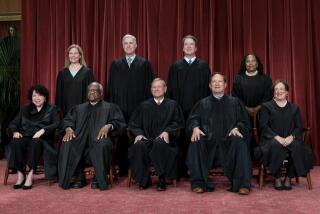Supreme Court Holds to Affirmative Action
- Share via
WASHINGTON — The big news about the Supreme Court’s affirmative-action decision last week, Wygant vs. Jackson Board of Education, was not who won but who lost. Ten laid-off white teachers who protested a racial preference for blacks won their case, but the Reagan Administration, which supported them, lost. Another Administration effort to undermine the civil-rights laws has apparently failed.
This Administration took office committed to rolling back the civil rights of minorities and women. Whether the issue was voting rights, tax exemptions for segregated schools, federal funds for recipients practicing sex discrimination, school busing, minority business set-asides, affirmative action or discrimination against the aged or the handicapped, the Reagan Administration has consistently opposed the claims of minorities, women and other disadvantaged groups.
Race or gender preferences are especially sensitive--clashes over this issue between some Jews and blacks have shaken the civil-rights coalition. Atty. Gen. Edwin Meese III, Assistant Atty. Gen. for Civil Rights William Bradford Reynolds and other Administration strategists have therefore focused their attacks on programs establishing goals and timetables for achieving certain minority and other representation in employment and other contexts.
So far, the Administration assault has been surprisingly ineffective. It has even failed to repeal Executive Order 11246 that requires hiring goals and timetables by government contractors, partly because the very employers on whom the Administration was counting for support, including the National Assn. of Manufacturers, have urged that affirmative-action rules be retained. The Administration has also had to contend with numerous studies, including one by its own Labor Department, showing that affirmative action does in fact produce many more jobs for minorities and women--and usually with no opposition from other employees. “Affirmative action has helped, not hindered,” said a Boeing Co. spokesman.
In 1984, however, Administration efforts seemed to bear some fruit. Earlier, the Supreme Court had upheld racial preferences in education, private employment and government contracts, though always by a sharply and sometimes angrily divided Court. In a 1984 case from Memphis, Tenn., the court was faced with perhaps the saddest kind of situation: layoffs in a time of fiscal stringency. In a sharply splintered 6-3 decision, the court ruled that when seniority conflicted with racial preference, seniority won.
That result surprised no one--seniority has always been a special favorite of the court and there is something especially troubling about taking away a job from someone who has worked for a long time in order to keep a more junior person. The court also suggested, however, that federal courts may not order or approve any racial group preferences in hiring or promotion but could only provide relief for specific individuals who could prove they had actually been discriminated against. Were that suggestion to become law, many thousands of court-sanctioned affirmative-action programs affecting millions of workers would be thrown out, and thousands more voluntary programs would be jeopardized.
The Administration fastened on the court’s suggestion and began a campaign to eliminate all these programs. It failed, miserably. Assistant Atty. Gen. Reynolds first wrote to 51 localities urging them to repudiate their affirmative-action programs; he was turned down by almost all, often with a curt, “Stay out of our affairs, we’re doing fine.” He went to court again and again seeking a broad construction of the Memphis case and lost every time.
Last year, the issue finally reached the Supreme Court in another layoff case, this time from Jackson, Mich. The Jackson school system had long been sharply divided on racial lines. Under pressure from the state, the school board had agreed to hire more minority faculty members. Within two years, however, economic pressures forced layoffs--a constant problem in the 1970s for local governments--especially in a state as economically battered as Michigan. This wiped out the minority gains; the standard “last hired, first fired” seniority approach meant that newer minority teachers were fired first.
Other localities saw the same thing happen. In New York, for example, more than half of all Latino city workers lost their jobs in the 1974-75 fiscal crisis.
The Jackson board and the teachers union therefore agreed in 1972 to override seniority to the extent necessary to maintain the racial gains that had been achieved.
In 1981, Wendy Wygant and nine other tenured white teachers were laid off while some minority probationary teachers were retained. The white teachers sued. The board defended its plan on grounds that it was trying to remedy the effects of past “societal discrimination” and to keep minority teachers as role models for the minority students.
The Justice Department jumped into the case on the side of the white teachers, arguing that the only constitutionally acceptable remedy for past discrimination is one that “provides relief to an (identified) individual who was personally victimized by the discrimination,” relying in part on its reading of the Memphis case.
Wendy Wygant won 5-4, because five justices were unwilling to allow a race preference in order to remedy societal discrimination or to retain role models. The Justice Department position, however, lost. In a court dominated by Nixon-Ford-Reagan appointees, perhaps the unkindest cut of all was administered by President Reagan’s appointee, Sandra Day O’Connor.
For though the court ruled on behalf of the white teachers--a result that surprised few, given the Memphis case and concern for seniority--at least eight members of the court seemed to accept the notion that an employer could remedy past discrimination by race-preferential hiring goals for a minority group, and need not limit that remedy to identified individual victims of proven discrimination.
Justice O’Connor went further. Not only did she think “it is agreed that a plan need not be limited to remedying specific instances of identified discrimination,” but she suggested that “a carefully constructed affirmative-action program” was acceptable to remedy not only past discrimination but also to promote racial diversity, as in the 1978 UC Davis Medical School case, and for other purposes, such as effective police work or firefighting. Nor does the past discrimination actually have to be proved. If the plan is voluntary, the employer only needs a “firm basis” for believing the remedy is necessary.
Two more cases remain on the court’s docket. In one, racial preferences in promotions for Cleveland firefighters are at issue; in the other, numerical goals for union membership are involved. They will be decided by July and both contain enough differences from the Wygant case to make prediction too risky.
Indeed, it would be nice if we could remove race or gender from the hard decisions about allocating society’s benefits and burdens. Unfortunately, nearly four centuries of American history, marked by abuses to these group identities, make that impossible if we are to overcome the terrible legacy of those years. As Justice Blackmun said in the UC Davis case, “In order to go beyond racism, we must first take account of race. There is no other way.”
More to Read
Get the L.A. Times Politics newsletter
Deeply reported insights into legislation, politics and policy from Sacramento, Washington and beyond. In your inbox twice per week.
You may occasionally receive promotional content from the Los Angeles Times.










